SERVICE GRAVE
PATRICK EDWARD CLARK (grave 98)
SERGEANT (Air Gunner)
230 OPERATIONAL CONVERSION UNIT
MY STORY
Died: 14th July 1951
It was the 14th July 1951 and the weather at Scampton was less than ideal for night flying training. The cloud-base was down to 200ft and visibility below that was only 3000yds. The pilot of Avro Lincoln RA692, Graham Peter was attached to 230 Operational Conversion Unit (OCU) and was learning to fly the RAF’s most capable strategic bomber of the time.
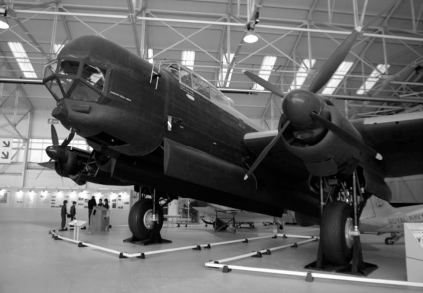
A Lincoln Bomber displayed at the Cosford Air Museum.
The aircraft had been designed in World War Two as a development of the famous Lancaster, but the changes made were so radical that it had to be regarded as a totally new aircraft type and it became known as the Lincoln.
Training new pilots is always a balance of ensuring that they have the necessary skills and letting them fly solo to develop those skills.
In this case, it looks likely that an error of judgment had been made and with only seven hours of night flying experience, Flight Lieutenant Peter had been put in command of a four-engine heavy bomber and its crew of six to practice night landings.
Due to the poor weather, Flight Lieutenant Peter was making a Beam Approach to Scampton.
At some point, he must have decided that his aircraft had drifted off the approach and that he should go-around for another try.
This is where inexperience took its toll, attempting to climb away with full landing flap still selected, the pilot lost control and at 03:12 in the morning the aircraft crashed at Welton Grange Farm. Missing the farmhouse by just 300 yards, the occupants were quickly awoken by the explosion. First on the scene was the Dairyman Norman Crowson, but the fierce flames of the kerosene-fuelled fire prevented any attempt at rescue.
It was later found that the entire crew had in any case been killed instantly on impact. Mrs Mary Wade, who also lived at the farm, gave her account to the Lincolnshire Echo of what must clearly have been a terrifying sight as follows.
“I was awakened by a terrific roar as the plane went over. It took off some files and then I saw something like a flash of lightning. There was a terrific explosion that shook the building. I went to my bedroom and saw that the plane was a mass of flames”
The aircraft had crashed into a field occupied by 50 pedigree Ayrshire cattle.
Despite the wreckage being spread over a wide area, the cattle had a remarkably lucky escape as they were all completely uninjured.
As well as those buried at Scampton, Flying Officer F Cousins DFC and Bar of Wakefield, Sergeant E Newman of Middlesbrough, Sergeant A J Fitzgerald of Ontario Canada and Cadet Engineer N Moss of Ealing were also killed. The investigation into the accident revealed the inadequate night flying training that Flight Lieutenant Peter had received and made the following recommendation:
“Pilots selected for courses at No 230 OCU should have at least 10 hours recent solo experience at night as captain on Wellington or comparable aircraft”
The following gives a remarkable insight into the shock of receiving the news of the loss of a loved one, particularly at a time of peace, coming, as it did, six years after the end of the Second World War. Alice Patricia Clark writes about the death of Sergeant Patrick Edward Clark in this incident:
A Knock At The Door by Alice Patricia (Pat) Clark (nee Paterson)
When the telegram arrived I was bathing Eileen; still not much more than a baby, not quite 15 months old and minus her twin, little Michael, dead at 6 months of age. My husband . . . . KILLED?
The RAF was a kind of euphemism for a shadowy hinterland inhabited by Eddie and his colleagues, but not one that I had visualized death in! The death of my young man; my child’s father – father-to-be of my unborn child. So young to die – with not even the hostilities of war as any sort of reason for his death.
I had looked upon the Forces as being a world in which protection was taken for granted, security a right, that could guarantee, or indeed protection was taken for granted; security a right, that could guarantee, or indeed should guarantee, liberty and safety.
As I tried desperately to digest and accept what I was reading, I had the overwhelming feeling of a great need to be alone; a feeling I could not indulge in. I had my baby daughter to consider.
Grief was a liberty I simply could not afford for her sake and the sake of the child growing inside me, who both needed the calm of a concerned mother; not the utter panic that was at that moment coursing through my mind and body.
As I was vainly attempting to digest the first telegram, hoping that somehow it Was a horrible dream, or a bad joke, a knock at the door heralded the certainty of yet another nightmarish piece of news.
For a few seconds I allowed myself to hope “maybe it’s Eddie?” He’s home to tell us it’s all a gross mistake. I almost ran to answer the knock, so vivid was my hope.
I pulled the door open with great face, actually anticipating his “Hello”, his reassurance.
His very presence had become such a vivid hope . . . . But it was not to be . . . . “Mrs Clark?” It was a second telegram giving more details of the tragedy that had taken Eddie’s life at 26 years old!
After these two telegrams, the second being pages long; for me it seemed to be a whole lot of nothing; a vacuum, that was creating a macabre state of oblivion compounding my reaction to this news, which was slowly, but surely mounting to manic proportions.
But, the outside world was normal; the sun shone, the traffic noise was still there. The sounds of people – still there, still passing by – How can everything remain normal when my life has just been shattered beyond belief?
Yet my mind was racing. I found myself thinking of and remembering in detail the only time in my life I had had too much to drink!
I was remembering because it was also the night Eddie and I first met. Back then I was attempting to appear normal in speech and actions just as I must also do now. But in the humour of my actions that day there was no similarity to the terror of trying to do the same now, on this day of horrifying news.
Now all of my actions were becoming complex rituals; each of my steps seemed to be leading nowhere. Total disorientation overtook my very being – yet I found some sort of strength to think I must not let anyone know of my terror, nor must anyone think I won’t get through the panic.
For my children’s sake I must get through it. It will be a lesson I’ll teach myself in surviving – but – how long will it take? Will it be one year? . . . . twenty years? The answer is . . . . I was 21 years old when I received those telegrams but I never have gotten over it, even all these years later my mind and thoughts can transfer so easily and with acute clarity, back to that day that changed my life forever.
In one moment of time I was transformed from being married, mother of twins, one dead, pregnant again and husband killed. I was a widow and not yet 22 years old.
My greatest source of joy, my children, especially Ken – he has grown to manhood now and is so very much like Eddie that my carefully built up guard occasionally slips and a few tears trickle down my cheeks as I look at Ken . . . . and see only his dad, Eddie!! Eddie always said if it’s a boy we’d call him Kenneth after his navigator. “A boy should know where he’s going in life and how to get there.”
Unexpected knocks at my door, all these years later, still hold fear and panic for me in a pavlovian reflex . . . . I still feel my heart thud with trepidation as I go to do what should be a basic and simple task – to answer the knock at the door.

Eddie, home on leave in the late 1940s.
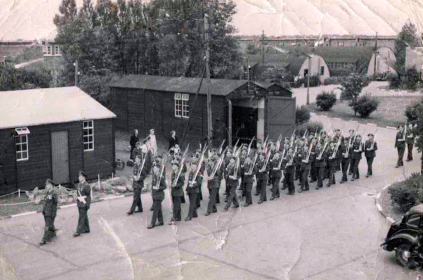
Treasured Clark family photographs showing the funeral and the full Military Honours accorded to it.
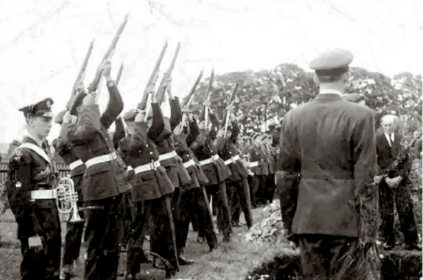
Graveside Guard of Honour – Clark family archive.
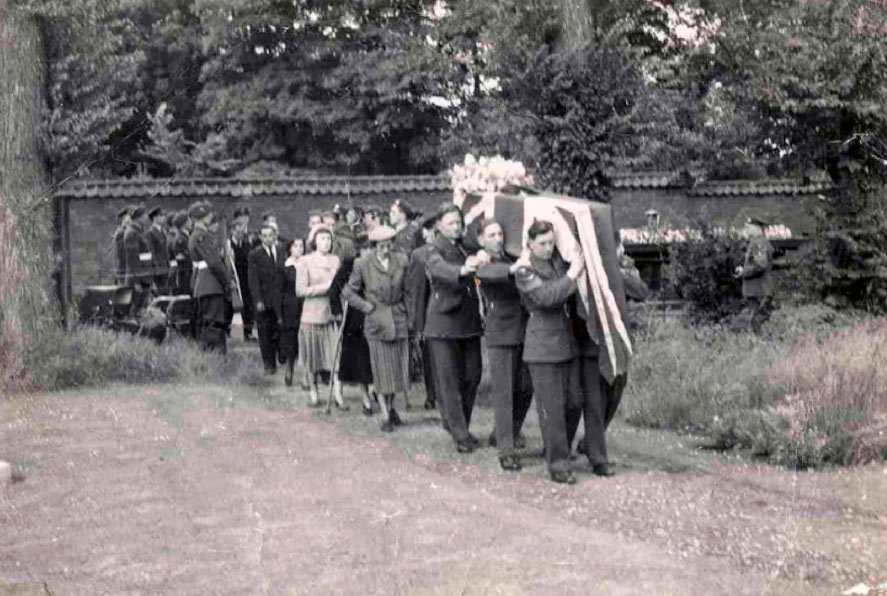
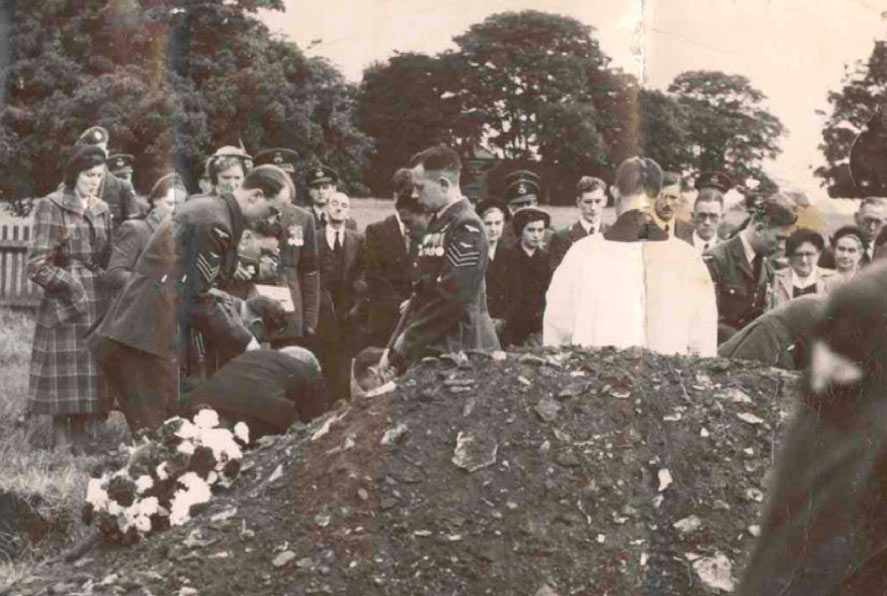
In the picture above, Mrs Clark is the lady in the light coloured beret behind the stooping RAF Sergeant. At the time she was five months pregnant with son Ken.
